01/03/2018
Living on the north-west tip of the Inishowen Peninsula is the 230-meter high Dunaff Hill. This isolated hill is hemmed in by two large bays with Dunaff Bay to the south and Rocktown Bay to the north, which in turn creates this huge Dunaff Headland. The headland has a four-kilometre stretch of very exposed and high, sea cliffs running along its western circumference to a high point of 220 meters above the Atlantic Ocean below. It is at this highest point on the clifftops that the Bothanvarra sea stack lives below.
Bothán Mhara is a 70 meter high chubby Matterhorn shaped sea stack that sits in the most remote, inescapable and atmospheric location on the Inishowen coastline. It sits equidistant from the bays to the north and south of the headland and is effectively guarded by 4 kilometres of loose, decaying and unclimbable sea cliffs.
This is the story of the first and to date the only ascent of this lonely and tricky-to-access sea stack. It took five visits and almost 10 climbing partners over four years from the first visit to standing on top and due to a sequence of quite unusual events the first ascent ended up being a free solo.
The Film of the Ascent of Bothanvarra
It was in 2010 when I first paid a visit to the summit of Dunaff Hill and from the clifftops, I caught my first glimpse of Bothán Mhara. This was of course on a day of lashing rain and with a suitably pounding ocean surrounding the base of the stack, and so, an ascent of Bothanvarra was buried in a to-do list of epic proportions.
And so to 2013 when we were at Fanad Head to do a film shoot for Failte Ireland and an abseil off the top of the famous Fanad lighthouse. It was on this occasion that I saw the true nature of the beast across the bay at Dunaff Head from a totally different perspective and so it was game on. Bothán Mhara had just gone to the top of the to-do list. A week later and in a party of four we started hiking up Dunaff Hill to have a wee look at gaining the stack from the summit of the sea cliffs by descending to sea level and taking a sea passage from there. Alas on this visit it became very apparent that this was a bit of a monster sea stack with major access and logistical problems but a lot was learned from this visit and numerous cunning plans were formed for future visits.
In October 2013 accompanied by Sean O'Keefe and Julia from London, we descended the 200-meter high gully to the south of the stack from the clifftops to a monster storm beach at sea level. It was then a 300-meter sea passage to the base of the stack from here. On this occasion we made it on to the base of the stack but alas the sun only arrived on the stack very late in the afternoon and alas the entire stack was soaking wet and the climbing on the seaward face looked very involved. We retreated and re-ascended the gully as evening and rain began to approach.
Julia on the storm beach at the base of Dunaff Head
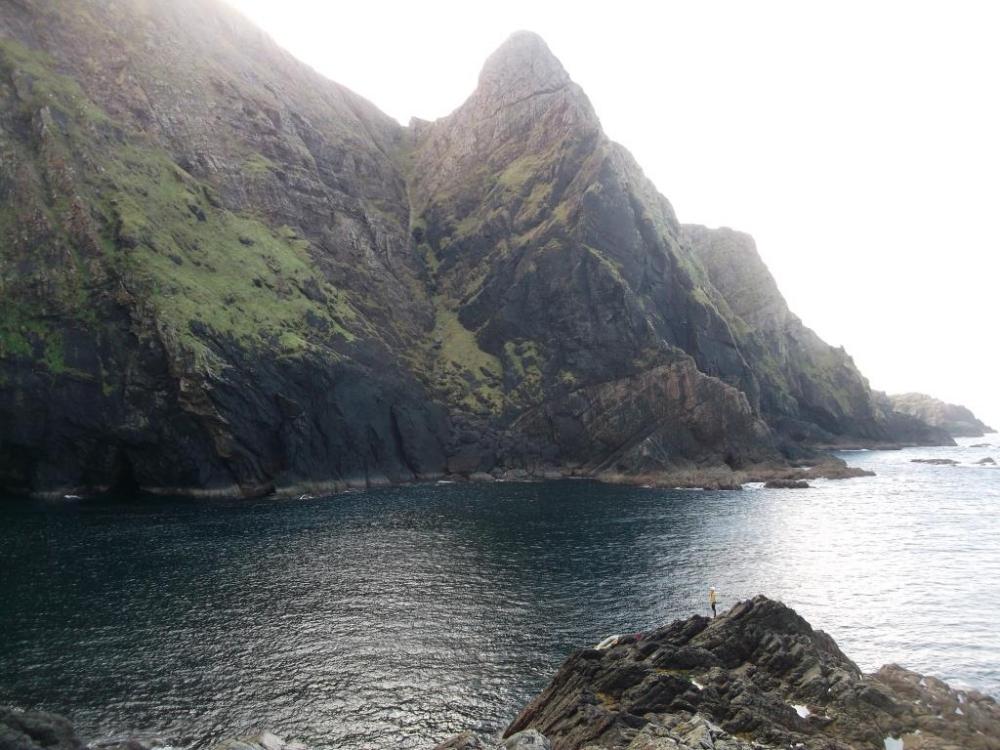
Standing on Bothán Mhara looking back at the descent gully
In May 2014 I made a fourth visit and an attempt at the stack, this time playing out with Louise O'Connor. On this occasion we had a slight change of plan as we hammered in a stake and abseiled/scrambled down the steeper gully directly facing the northern tip of the stack. We descended this grotfest of a gully until about 20 meters above sea level, alas at this point with no sensible anchors and with 20 meters of steep slime-covered slabs to the hideous boulder beach death drop below us, we retreated. Again from this position just above sea level directly opposite the stack, there did not look to be an easy way to the summit, which gave me a mild note of concern.
After four attempts and having viewed all the available approach strategies, a very cunning plan was hatched. It had by this time become very apparent from the previous attempts that this was an Uber stack of epic proportions and it was now time to go it alone. This is not as foolhardy as it may first appear as logistically and practically being alone on such an endeavor, as it reduces potential collateral mishap but alas increases the commitment and fear factor to near epic proportions.
It was now the 24th August 2014 and I went for attempt five, sea conditions were perfect as there was a 12-hour window of less than 1 meter south-west motion and gentle winds were blowing offshore for the next 24 hours. This time I was accompanied by Aidan McGinley as the clifftop photographer and the cunning plan was to circumnavigate Dunaff Head by small inflatable dingy to access the base of the stack and solo climb to the summit.
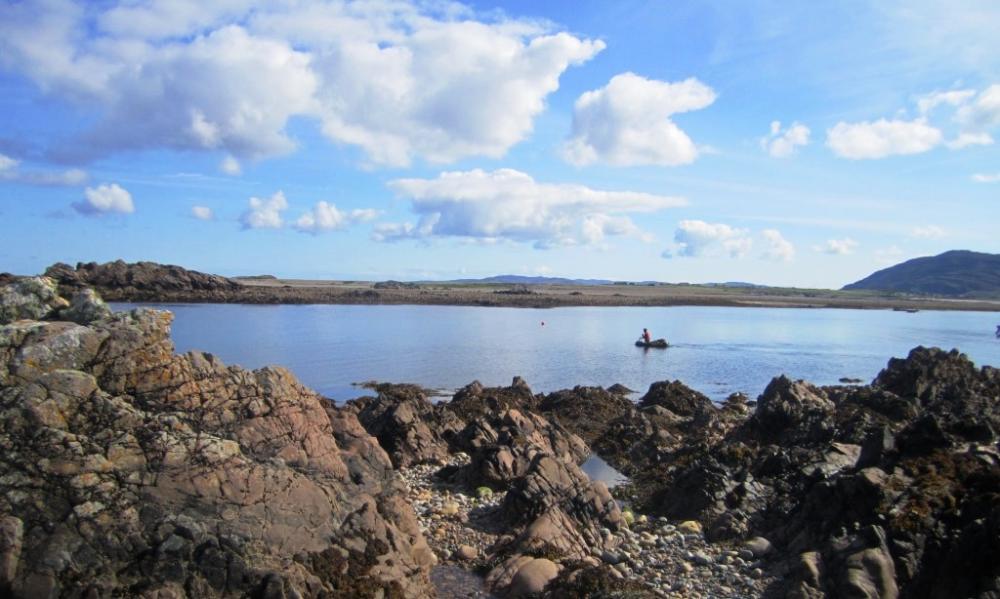
Paddle out to Bothanvarra around Dunaff Head
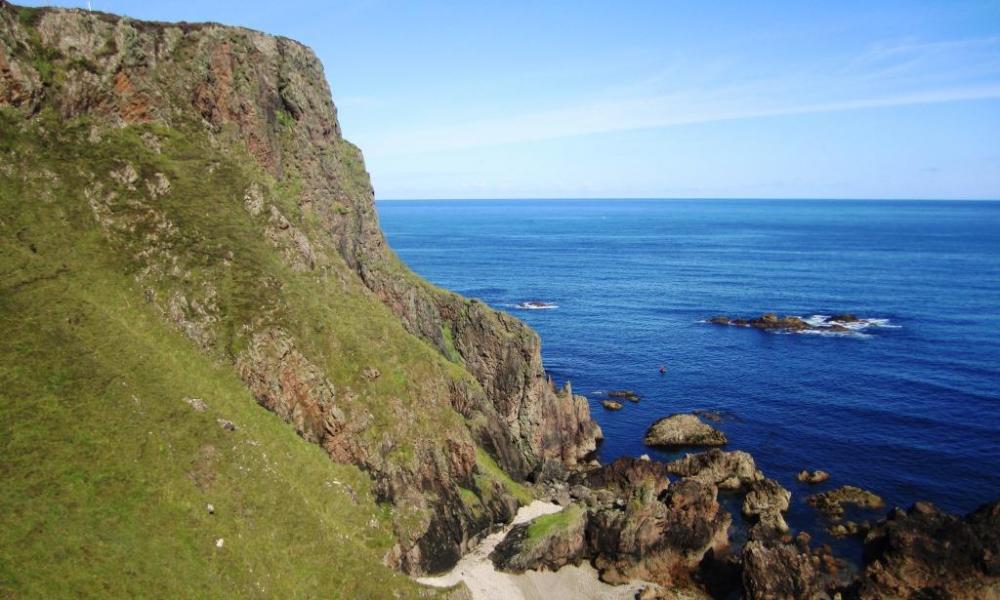
Approaching the northern tip of Dunaff head
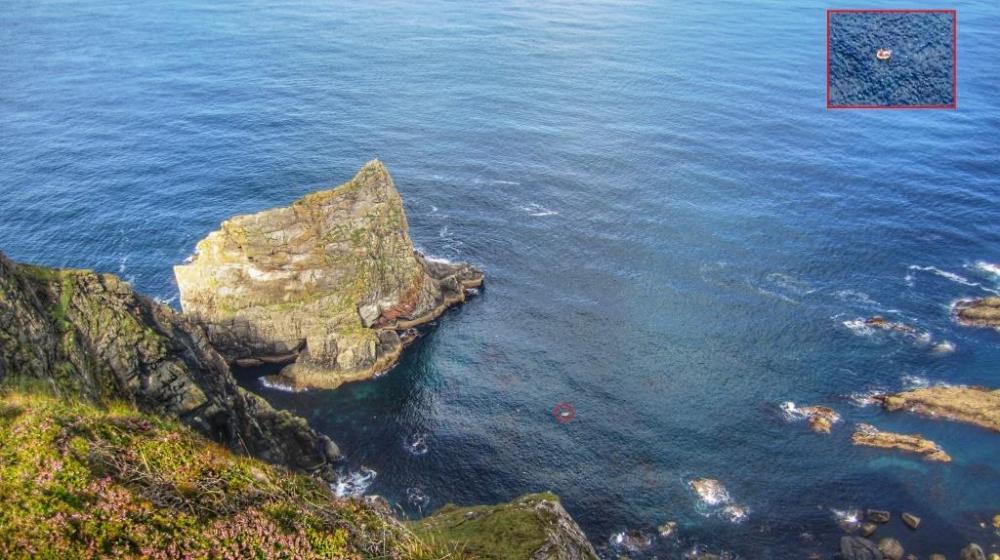
Approaching the base of Bothán Mhara
We arrived at Rocktown Harbour, the bay to the north of Dunaff Head and I immediately inflated the mighty vessel. This public accessed pier and harbour was the best and most obvious starting point. See Dunaff Head logistics for more logistics on climbing the stack. Whilst I set sail Aidan headed off up to the summit of Dunaff Hill to gain a bird's eye view of the proceedings. The sea state was nice and relaxed as I paddled around the coast below the inescapable and extremely scary ever-growing sea cliffs looming above me to my left. After about 30 minutes and about 1 and a half kilometres of atmospheric paddling, I landed on an offshore skerry approximately 200 meters to the north of Bothán Mhara. From this sea-level position, the stack towering above me looked very much like suicide as all-round me on this very exposed wee stance the entrance to Hades became a very real doorway to the further. I decided to simply leave the stack summit to someone else as a rising tide of fear was beginning to dull the real-world senses to a point where it was difficult to tell whether I was really there or simply in a dream having already drowned on the sea approach in the last 30 minutes.
I returned to the boat and began paddling home through the channel between the stack and land. I had decided that as I was no longer going to climb the stack that a circumnavigation of Dunaff would be a great alternative way to spend the day. It was then with a lightning bolt of total recall, a crystal clear memory of a groove system running up the south face came to mind as I paddled towards the stack. I continued to paddle into a position approximately 150 meters to the south of the stack to view the south face, YES the groove system was there and it looked a very real proposition. Primal fear had now been replaced with endorphins of the highest quality as I landed on the stack and hauled the boat and gear onto a most excellent non-tidal stance.
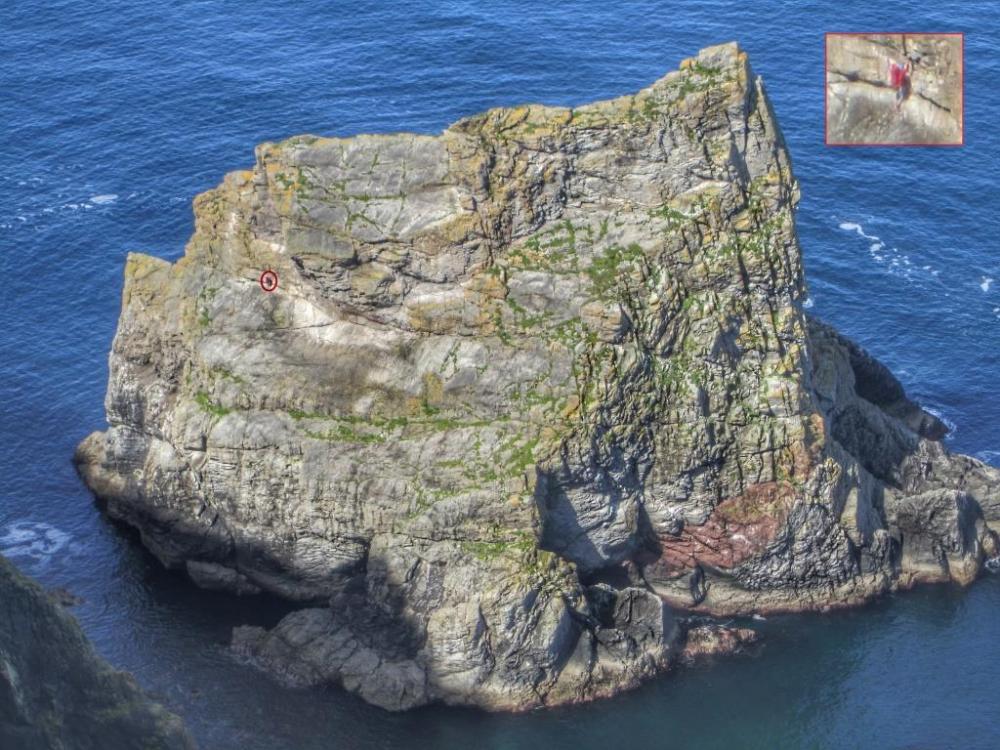
Just below the hardest bit of climbing on Bothán Mhara Sea Stack
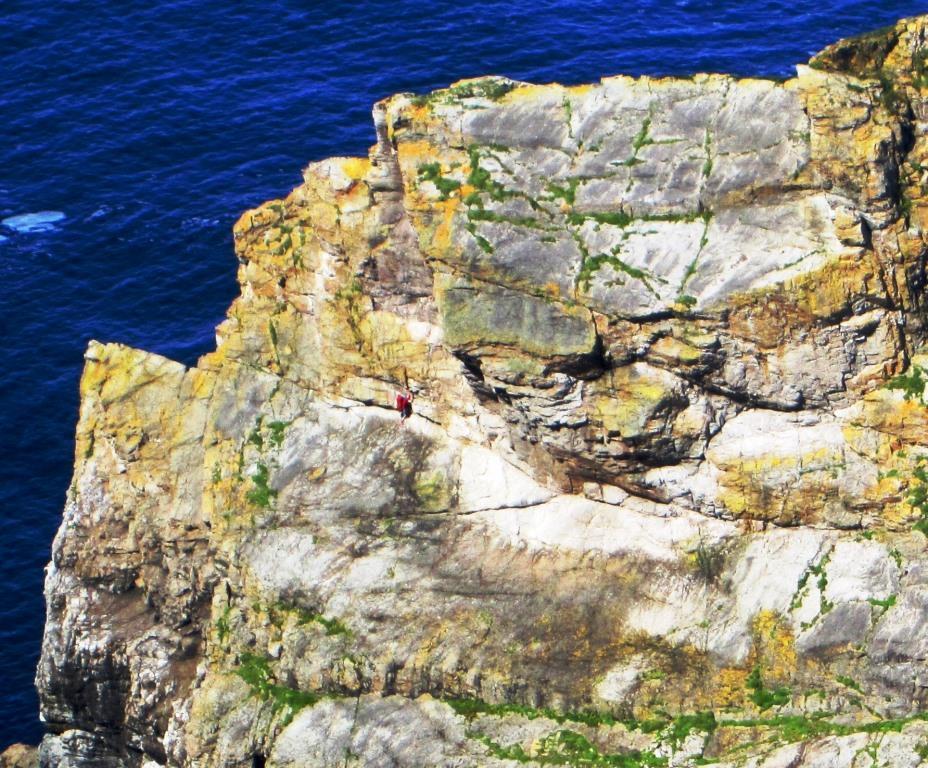
Climbing towards the summit ridge
The best way forwards from here was to simply freesolo the ground above until it became necessary to employ the inverted gri-gri climbing partner. The climbing was easy but very loose and just (and I do mean just) the right side of terrifying. I just continued climbing up through a huge hanging slab and bypassing monster roofs to my right, I found myself on the huge summit ridge. A quick glance at my feet and there was plenty of rock to create abseil anchors, the sense of relief was overwhelming. It was now a scramble to the stacks highest point and I now knew I could safely get off the summit, it was a bit like finding a hundred sets of lost car keys at once! :-)
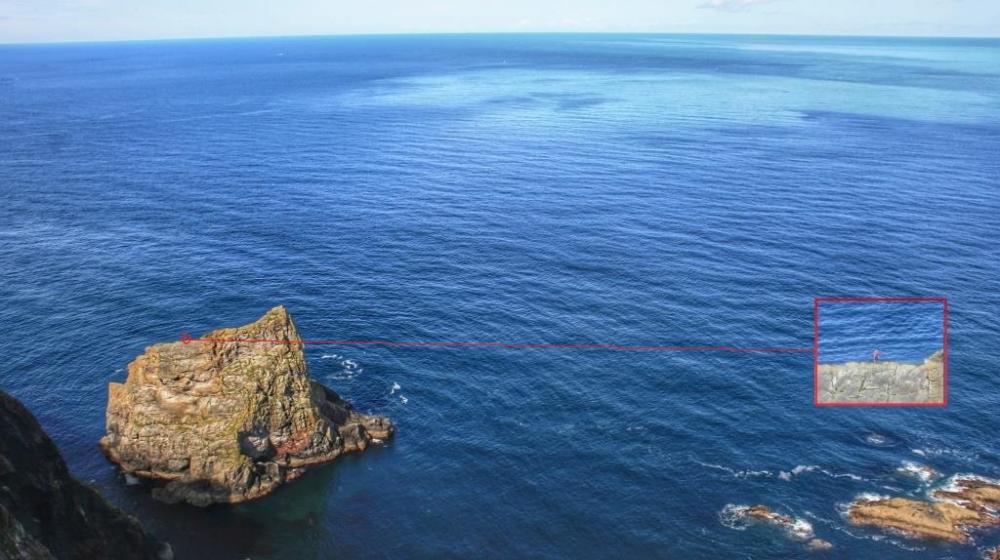
Walking along the summit ridge of Bothán Mhara
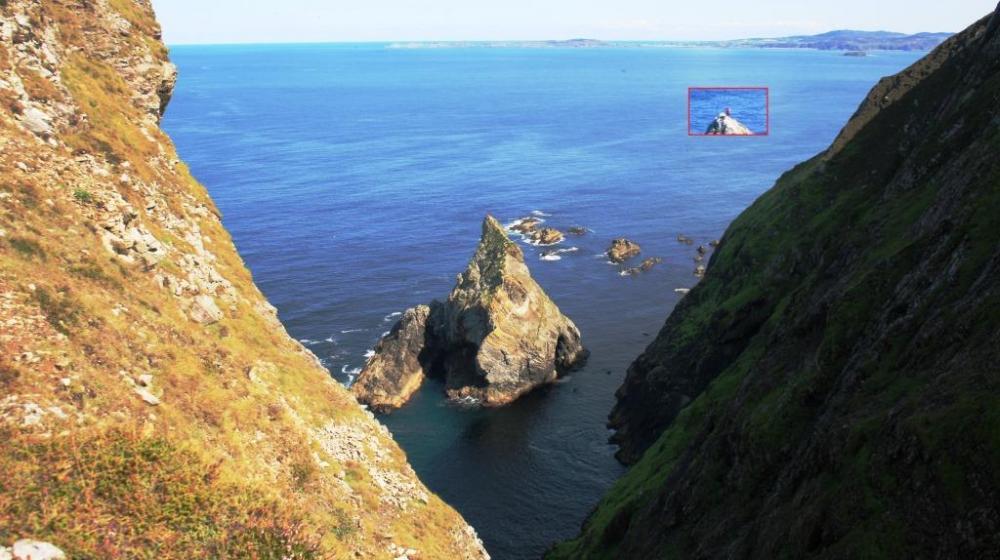
Looking very small standing on the summit of Bothán Mhara
A swift scramble along the summit ridge on to the small very exposed summit. The summit ridge of Bothán Mhara is an excellent 50-meter ridge scramble along a true knife-edge with an ever-growing sense of exposure as the potential death drop either side of you increases to a 70-meter crescendo at the pinpoint summit. As with all mountaineering objectives the summit usually only marks the halfway point, but in the case of the unknown this summit marked the end of the uncertainty.
With hindsight, the uncertainty on the outward journey was the most intense I have ever experienced. Will I make the long unescapable sea passage? Will I be able to climb the stack? Can I then get back down off the stack's summit? These were three reference points of top-end mental anguish which faded upon reaching this outstanding nautical summit.